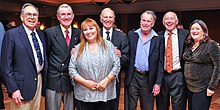
Cluster II is a space mission of the European Space Agency, with NASA participation, to study the Earth's magnetosphere over the course of nearly two solar cycles. The mission is composed of four identical spacecraft flying in a tetrahedral formation. As a replacement for the original Cluster spacecraft which were lost in a launch failure in 1996, the four Cluster II spacecraft were successfully launched in pairs in July and August 2000 onboard two Soyuz-Fregat rockets from Baikonur, Kazakhstan. In February 2011, Cluster II celebrated 10 years of successful scientific operations in space. In February 2021, Cluster II celebrated 20 years of successful scientific operations in space. As of March 2023, its mission has been extended until September 2024. The China National Space Administration/ESA Double Star mission operated alongside Cluster II from 2004 to 2007.

An ejecta blanket is a generally symmetrical apron of ejecta that surrounds an impact crater; it is layered thickly at the crater's rim and thin to discontinuous at the blanket's outer edge. The impact cratering is one of the basic surface formation mechanisms of the solar system bodies and the formation and emplacement of ejecta blankets are the fundamental characteristics associated with impact cratering event. The ejecta materials are considered as the transported materials beyond the transient cavity formed during impact cratering regardless of the state of the target materials.

Margaret Galland Kivelson is an American space physicist, planetary scientist, and distinguished professor emerita of space physics at the University of California, Los Angeles. From 2010 to the present, concurrent with her appointment at UCLA, Kivelson has been a research scientist and scholar at the University of Michigan. Her primary research interests include the magnetospheres of Earth, Jupiter, and Saturn.

Solar wind Magnetosphere Ionosphere Link Explorer (SMILE) is a planned joint venture mission between the European Space Agency and the Chinese Academy of Sciences. SMILE will image for the first time the magnetosphere of the Sun in soft X-rays and UV during up to 40 hours per orbit, improving our understanding of the dynamic interaction between the solar wind and Earth's magnetosphere. The prime science questions of the SMILE mission are

Alexander J. Dessler was an American space scientist known for conceiving the term heliosphere and for founding the first Space Science Department in the United States.
Rumi Nakamura is an Earth scientist at the Austrian Academy of Sciences. She works on solar-terrestrial interactions, with a particular focus on the terrestrial magnetosphere. Nakamura won the 2014 European Geosciences Union Julius Bartels Medal.

Nancy U. Crooker is an American physicist and professor emerita of space physics at Boston University, Massachusetts. She has made major contributions to the understanding of geomagnetism in the Earth's magnetosphere and the heliosphere, particularly through the study of interplanetary electrons and magnetic reconnection.
James F. Drake is an American theoretical physicist who specializes in plasma physics. He is known for his studies on plasma instabilities and magnetic reconnection for which he was awarded the 2010 James Clerk Maxwell Prize for Plasma Physics by the American Physical Society.
M. Joan Alexander is an atmospheric scientist known for her research on gravity waves and their role in atmospheric circulation.

The Dungey cycle, officially proposed by James Dungey in 1961, is a phenomenon that explains interactions between a planet's magnetosphere and solar wind. Dungey originally proposed a cyclic behavior of magnetic reconnection between Earth's magnetosphere and flux of solar wind. This reconnection explained previously observed dynamics within Earth's magnetosphere. The rate of reconnection in the beginning of the cycle is dependent on the orientation of the interplanetary magnetic field as well as the resultant plasma conditions at the site of reconnection. On Earth, the reconnection cycle takes around 1 hour, but this differs from planet to planet.
Shamita Das is an emeritus professor at the University of Oxford and an emeritus fellow at Exeter College. She is known for her research on earthquakes, in particular the speed that earthquakes can propagate through the earth.
Rachel Abercrombie is a seismologist at Boston University known for her research on the process of earthquake ruptures.
Jennifer Logan is an atmospheric scientist known for her research on how human activities influence the atmosphere, particularly with respect to biomass burning and the ozone hole.
Jane Lee Fox is a physicist known for her research on the atmosphere of planets including Mars and Venus. She has many published works at her current institution, Wright State University.
Janet Kozyra is a heliophysicist who works on solar superstorms. She has used data from Imager for Magnetopause to Aurora Global Exploration (IMAGE), to show that Earth interacts with solar energy during solar storms.
Antoinette (Toni) Galvin is space physicist at the University of New Hampshire. She is known for her research on the solar wind.
Mary Hudson is the Eleanor and Kelvin Smith Distinguished Professor of Physics at Dartmouth College. She is known for her research on the weather patterns that occur due to solar eruptions. She was elected a fellow of the American Geophysical Union in 1984.
Michelle F. Thomsen is space physicist known for her research on the magnetospheres of Earth, Jupiter, and Saturn.
Vania Koleva Jordanova is a physicist known for her work on space weather and geomagnetic storms. She was elected a fellow of the American Geophysical Union in 2021.

James Wynne Dungey (1923–2015) was a British space scientist who was pivotal in establishing the field of space weather and made significant contributions to the fundamental understanding of plasma physics.









